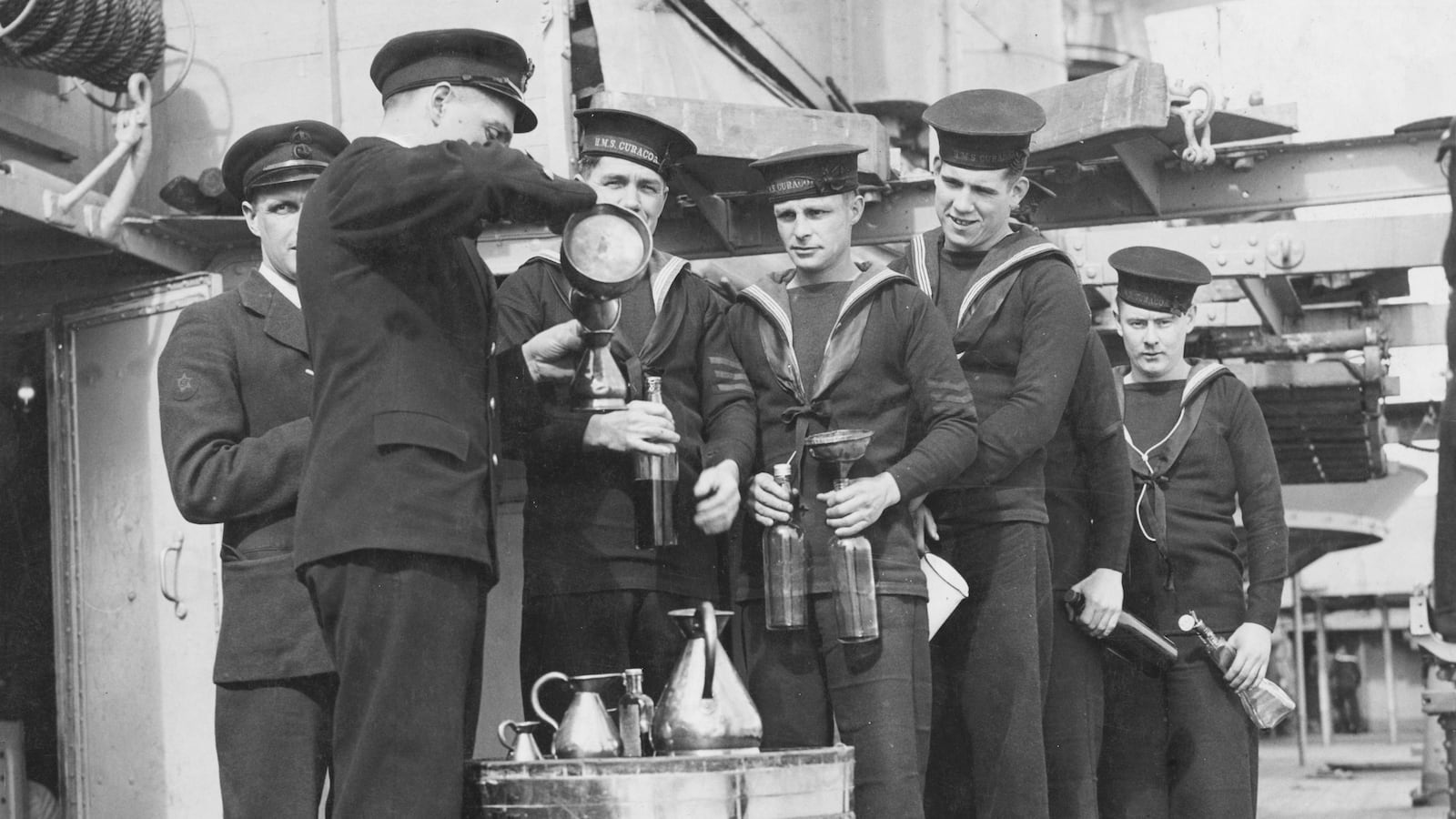Here’s your game plan for this Sunday: download and crank up a sea shanty, hold aloft a tot of dark, tasty rum, observe a moment of silence, and then swiftly knock it back.
For Sunday marks the 46th anniversary of Black Tot Day. On July 31, 1970, the British Royal Navy ended a centuries-old hallowed tradition: the issuing a daily dram of liquor to sailors aboard its ships. When the day arrived, sailors around the world gathered for a final tot, and the remnants of the barrels were ceremoniously dumped into the ocean.
Afterward, the navy’s rum budget was diverted into providing other sort of entertainment for sailors. This included bus excursions, golf outings, and equipment for discotheques.
On second thought, perhaps we should drink a double tot.
Military forces were once, essentially, alcohol-powered fighting machines. The Dutch navy provided gin to its sailors. The French (naturally) got wine. The American Continental Navy, established to fight in the War of Independence, included in its charter the issue of a half pint of rum daily to every man, with more doled out for extra duty and during military engagement.
But the British navy had the most rococo, highly evolved, and well-documented history of drinking on the high seas.

The daily tot likely started for a simple reason. Water in the casks would often develop algae and taste putrid and sour. And beer (also rationed for centuries) didn’t hold up well in humid heat; captain’s letters often referred to the beer on board as “stinking.”
Higher proof spirits, however, retained their bright, sweet flavor far longer (even improving in the barrel), and as such were much in demand by seamen living on a diet of bland porridge and salted meat. Liquor rations may not have kept men hydrated, but at least it offered an oasis of tastiness.
More importantly, of course, alcohol offered a respite from the tedium of shipboard life. In their quarters below decks, men were stacked like cordwood in hammocks in airless spaces, living literal inches away from fellow sailors possessed of uncertain hygiene and almost-certain gastro-intestinal distress. Naturally, the high point of any day was hearing the piper call sailors above decks to receive their daily allotment of spirits. “Good liquor to sailors is preferable to clothing,” noted Woodes Rogers, an English privateer and later governor of the Bahamas, in 1712.
But what liquor? Seamen were rationed fortified wines and brandy when in the waters of Europe and Africa. When the British navy turned its sights to West Indies and North America, “naval rum” became an essential staple. By 1740, writes James Pack in his detailed 1982 history of the spirit, “the rum issue, as the daily alternative to beer, was common practice on the West Indies station.”
Naturally, sailors tended to quaff their daily pint-sized ration all at once. This led to predictable problems. Traversing lines high in the rigging was difficult enough when sober. And even greater problems arose when in port. Drunken sailors got into fights and were killed, and were more easily shanghaied or recruited aboard other ships when potted and staggering about.
Famous and revered Admiral Sir Edward Vernon oversaw ships in the West Indies for decades. He thus saw the effects of rum first hand. It was responsible for “stupefying [his sailors’s] rational qualities,” he wrote, resulting in “fatal effects to their moral as well as their health.”
In August 1740, he issued an edict that contained two sweeping changes to the rum rations. First, it was to be disbursed twice daily, thereby discouraging wholesale guzzling. More significantly, he called for it to be significantly watered down: one part of rum to four parts water.

Sailors called the new drink “grog.” Grogram was a type of gum-coated cloth that shed rain nicely and was supposedly favored by Vernon. His men had nicknamed him “Old Grogram,” and so a shortened version of the name made the leap to drink, where it has endured to this day.
The diluted grog ration was formally incorporated into the naval regulations in 1756, which was followed by a gradual, 260-year history of further watering down. The ration was cut in half in 1823, and then halved again in 1850.
Over the next century, the interest among seaman in partaking of the tot started to fall off; by the 1950s, only a third of navy sailors lined up for it. Then came the Breathalyzer. A meddlesome British newspaper used one to demonstrate that a sailor could still be legal drunk after consuming his ration.
The House of Commons then took up the debate, and eventually decided that what you do with a drunken sailor is not give him control of nuclear weapons and high-tech electronics. A lump sum of several million dollars was paid into the Sailor’s Fund to compensate for the loss of rum, which went to pay for the disco balls and whatnot.
On July 31, 1970, British navy personnel around the globe donned black armbands to mark the lamentable day. Mock funerals were staged. A British guided-missile destroyer tied up at Pearl Harbor in Hawaii was the nearest British ship to the international date line, so it was the last to do away with the tot.
Crewmen assembled on deck of the HMS Fife, tossed back their final dram, then tossed glasses into the harbor followed by a barrel.
And a centuries-old tradition came to an end. But in doing so, it gave birth to another tradition.
So ration yourself a tot (neat, no ice, a blend of Jamaican, Guyanese, and lighter rums), and salute the sacrifice of sailors everywhere.






